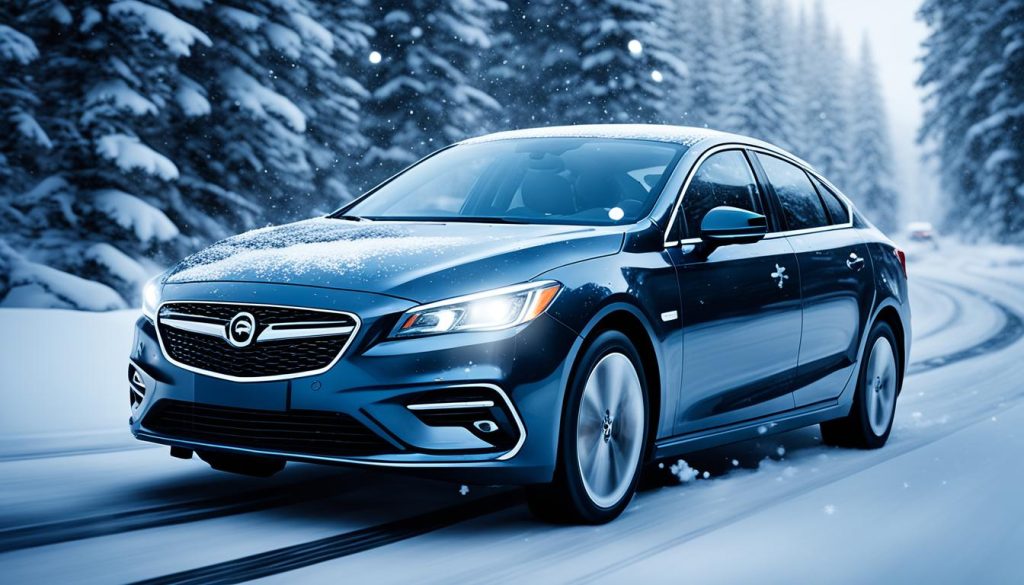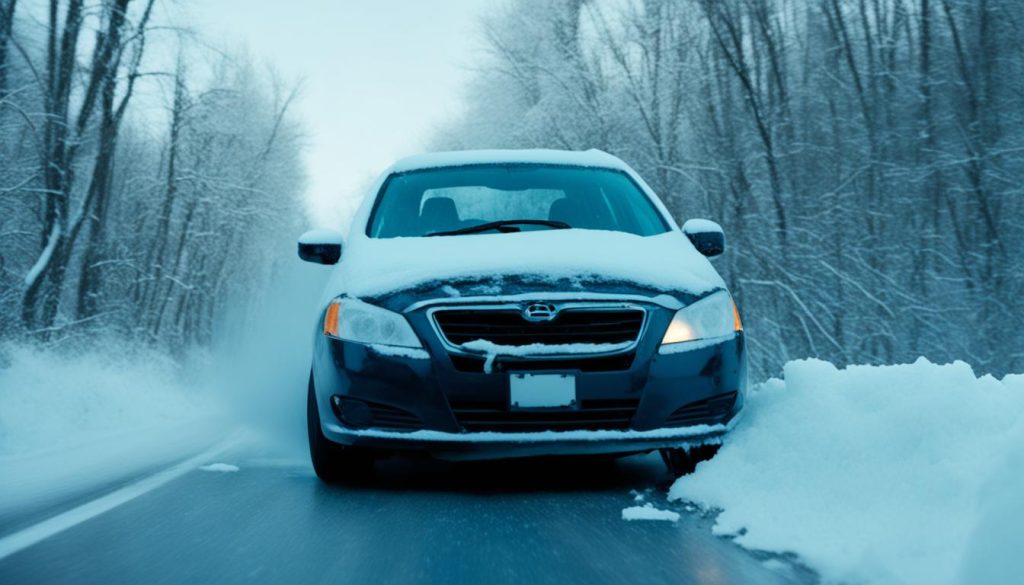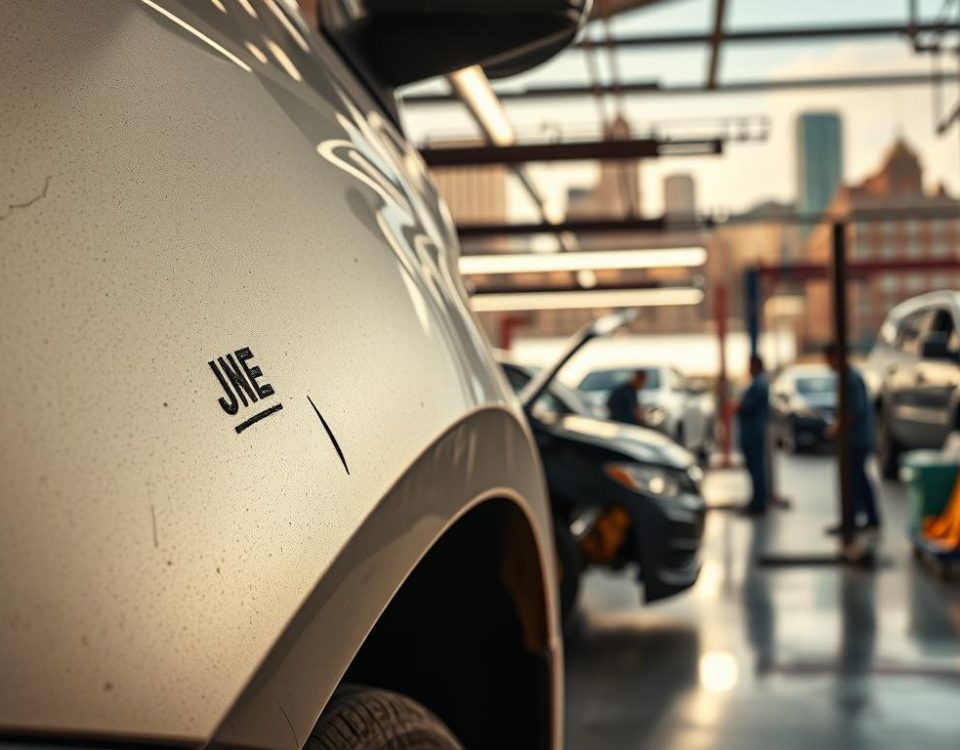
How to Improve Road Safety for Your Fleet Vehicles

The Importance of Post-Collision Vehicle Inspections
Driving in winter can be dangerous. Severe weather like storms and ice make the roads risky. These conditions lead to many accidents and deaths each year.
Our group is serious about your safety, especially in bad weather. We’ve made a list of tips for winter driving. They’re here to help you stay safe and avoid accidents.
To drive safely in the cold, being ready is important. The American Automobile Association (AAA) has shared tips to help keep you safe. Here they are:
- Keep a bundle of cold-weather gear in your car.
- Properly inflate your tires and maintain enough tread.
- Ensure at least half a tank of fuel.
- Avoid warming up your vehicle in an enclosed area.
- Refrain from using cruise control on slippery surfaces.
- If possible, stay home and avoid unnecessary travel.
- Drive slowly and adjust your speed to account for reduced traction.
- Accelerate and decelerate gradually.
- Increase your following distance to five to six seconds.
- Understand brake usage and avoid unnecessary stops.
- Be prepared by checking your vehicle before hitting the road.
- Check the weather along your route and modify plans accordingly.
- Notify others of your travel plans.
If your car gets stuck in the snow, knowing what to do is critical. Here’s what to remember: Stay with your car, don’t do too much physical activity, and use visible markers to make your car stand out. Clear the exhaust pipe, keep warm, and save energy. Always listen to local advice and watch out for emergency vehicles.
Having an emergency kit in your car is a smart move. The kit should have an ice scraper, jumper cables, and a flashlight. Also pack warm clothes, a shovel, and food and water. A cell phone with a charger is important too. This kit can be a lifesaver during tough times.
Key Takeaways:
- Winter weather is a big risk for drivers, causing a lot of accidents and deaths.
- Following AAA’s winter driving tips can keep you safe.
- Being ready, including having cold-weather gear and checking your car, is vital.
- Know what to do if you get stuck in the snow and have an emergency kit with you.
- Always listen to local advice and be ready for anything on the road.
Be Prepared: Vehicle Maintenance and Emergency Kit
As winter approaches, preparing your vehicle is key. It’s important to have your car checked to stay safe on winter roads. Check the following:
Battery Performance
Ensure your car’s battery is healthy and working well. The cold can make batteries work harder. So, test it and change if needed.
Tire Tread and Pressure
Look at your tires to see if the tread is deep enough. Worn tires can be dangerous on snow and ice. Also, keep your tires at the right pressure for better control.
Brakes
Your brakes should be top-notch. Winter driving often requires sudden stops. Good brakes help prevent accidents.
Coolant and Antifreeze Levels
Don’t forget your coolant and antifreeze. They keep the engine from getting too cold or too hot. The right levels help the engine run well.
Windshield Wipers and Lights
Make sure your windshield wipers work well. Replace them if needed for clear vision. Check all lights to make sure you’re visible in bad weather.
Cooling System
Give your cooling system a check. This includes the radiator, hoses, and belts. It stops the engine from getting too hot, especially when standing still in the cold.
Having an emergency kit is also crucial. It helps you be ready for anything in the winter. Include these items in your kit:
- An ice scraper and snow brush
- Jumper cables
- A flashlight with spare batteries
- Warm clothing and blankets
- A shovel
- Kitty litter or sand for traction
- A first-aid kit
- Non-perishable snacks and water
- A cell phone and charger
With a well-maintained car and a good emergency kit, you’re set for safe winter driving. These steps help you stay safe and be ready for any challenges. This way, you can face the winter roads with confidence.
Plan Your Route and Drive According to Conditions
Safe winter driving starts with route planning and adjusting to weather conditions. Check winter weather forecasts and road conditions before your trip. This preparation helps you avoid risky travel times, keeping you safe.
In bad weather or on slippery roads, change how you drive. Slow down and leave more space between cars. This helps you stop safely. Also, keep your headlights on during the day for better visibility when it’s snowy or foggy.
Winter driving often leads to skids. To cut skidding risks, drive smoothly without sudden moves. If you start to skid, steer where the car is sliding. Don’t overcorrect. Doing this helps you get back in control.
Getting stuck in snow can happen, too. If you’re stuck, stay in your car and don’t tire yourself out. Clear snow from your car’s exhaust to keep dangerous gases out. Save your fuel and use markers to show you need help.
Here’s an image to show why route planning and safe driving are key:
Vehicle Equipment for Winter Weather
Equipping your vehicle for winter is crucial. Having the right tools ready helps you handle snowy, icy roads. This includes an emergency kit and specifically winter buddy tools.
Winter tires boost your car’s grip on icy and wet roads. They are made to handle cold weather. Having them makes your car safer in winter.
Don’t forget ice scraper and snow brush for your car windows. Being able to see clearly is key for safe driving. These tools make sure your view is not blocked.
Keep a shovel in your car during winter. It’s handy for digging your car out of snow or clearing a path. A shovel is a reliable tool when it snows.
Supplying your car with the right gear makes winter driving easier. Winter tires, an ice scraper, a snow brush, and a shovel are vital. They keep you in control and your view clear on winter roads.
Winter Driving Safety Technologies
Know your car’s safety tech for safe winter driving. Learn how they work in winter to make driving better.
One key safety system is the antilock brake system. It keeps the wheels from locking when you hit the brakes. This means you can steer your car better and avoid skidding on icy roads. Knowing how to use this system is crucial in emergencies.
Many cars today have driver assistance technologies that make driving safer. These include collision warnings, help staying in your lane, radar-based cruise control, and brakes that work for you if you don’t. Each tech tool makes driving in the winter less risky.
Being up to speed on your car’s safety features and using them well cuts down on accidents. This leads to a more secure time on the winter roads.

Tips for Driving in Specific Winter Conditions
Driving in the winter can be tough and dangerous. Each weather type needs its own driving style to keep you safe. Here’s how to drive in various winter conditions:
Driving on Snow
On snow-covered roads, slow down. This gives you time to react. Keep more distance from other cars to stop safely if needed. No quick moves, like sudden brakes or speeding, as they make your car lose control. Careful driving helps you tackle the snow without trouble.
Driving on Ice
Ice needs extra care. Cut your speed down a lot to stay in control. Give more space between cars because it’s harder to stop. Turn the wheel gently to prevent skidding. Don’t slam the brakes, but slow down slowly. Adjusting how you drive for icy roads keeps you safe.
Navigating Slippery Roads
Snow, ice, and slush make roads slippery. Go slow and steady with your moves. Face the direction you’re heading on the wheel, moving gently. Neither brake nor speed up suddenly to keep your tires planted. Stay alert and adapt. These tips make slippery roads less of a challenge.
Driving in Winter Storms
Winter storms are dangerous for driving. Stay home if you can during heavy storms. But if you must go out, watch for bad visibility and slick roads. Make sure your lights are on low and drive slower with lots of space between you and others. Stay focused on driving, and if it gets too rough, pull over safely and wait.
Your safety is top priority when driving in winter. Follow these tips to lower your accident risk and drive safely in winter.
What to Do in Case of an Accident
In winter, accidents happen despite our best efforts. If you’re in one, make sure everyone is safe first. Look for injuries and get medical help if needed. If possible, move the cars off the road.
Exchange information with the other driver, take photos of the scene, and call the police to report the accident.
Also, consider talking to an auto accident lawyer especially if it’s a big accident. A good lawyer will protect your rights and help you get what you deserve for your losses and injuries.

Ensuring Safety and Gathering Information
- Check for injuries and call for medical help, if necessary.
- Move vehicles out of traffic to a secure area.
- Exchange information with the other driver.
- Document the scene with photos.
- Contact the authorities to file a report.
Seeking Legal Guidance
After an accident, get in touch with an auto accident lawyer. They can walk you through the legal steps. A lawyer can help you understand your rights and deal with the insurance companies.
For more complex accidents, like figuring out who’s at fault, a skilled lawyer can help. They’ll make sure your side is heard and protect your rights.
Conclusion
Winter’s arrival means we must focus on road safety. To be safe, we should follow winter driving tips and be ready for anything. This includes preparing our cars, using necessary winter gear, and checking our routes based on the weather. These steps help us stay safe during the season.
Yet, accidents may happen no matter how careful we are. If there’s a crash, safety matters most. Make sure everyone is okay and keep a record of what happened. Getting advice from a car accident lawyer can help, especially in tough situations.
Being careful and ready can cut down on winter crashes. Driving in winter might be tricky, but it’s worthwhile to be safe. Let’s not forget to follow safety tips, take precautions, and drive wisely. This way, we can all enjoy a safe winter on the road.



